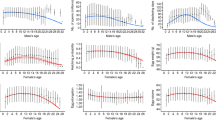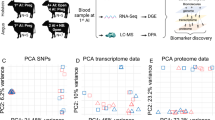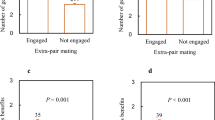Abstract
THE eastern meadowlark (Sturnella magna) and western meadowlark (S. neglecta) are sibling species of songbirds in secondary contact throughout a narrow zone of sympatry in central North America1–3. Field studies suggest that specific differences in vocalisations are the principal isolating mechanism and that hybridisation is limited in extent and possibly restricted to regions of recent contact4–7. The incidence of hybridisation is difficult to determine, however, due to their similar appearance, and there is uncertainty as to the recognition of some hybrids of known parentage7. Multivariate analysis alone offers no additional resolution to the problem8. A programme to breed and hybridise meadowlarks in captivity is one approach to determining the viability and fertility of hybrids. The difficulties inherent in the technique and the time required to amass adequate samples have precluded its use among avian systematists, with the exception of those working on some game species9,10. However, I now report that between 1966 and 1978 I was successful in inducing 25 captive meadowlarks to pair and produce 44 clutches of 158 eggs. Mixed matings among non-hybrids resulted in 90% fertility, not significantly different from the 87% fertility among eggs from pure matings, whereas the fertility of eggs from pairing of hybrids was only 10%. All eggs resulting from pairing the one surviving backcross hybrid were infertile.
This is a preview of subscription content, access via your institution
Access options
Subscribe to this journal
Receive 51 print issues and online access
$199.00 per year
only $3.90 per issue
Buy this article
- Purchase on SpringerLink
- Instant access to full article PDF
Prices may be subject to local taxes which are calculated during checkout
Similar content being viewed by others
References
Lanyon, W. E. Ecology 37, 98–108 (1956); Auk 79, 183–207 (1962).
Szijj, L. J. Proc. XIII Int. Ornithol. Congr. 176–188 (1963).
Rohwer, S. A. Trans. Kansas Acad. Sci. 75, 1–19 (1972).
Lanyon, W. E. Publ. Nuttall Ornithol. Club 1, 1–67 (1957).
Szijj, L. J. Z. Tierpsychol. 23, 677–690 (1966).
Rohwer, S. A. Evolution 27, 44–57 (1973); Occ. Papers Mus. nat. Hist. Univ. Kansas 44, 1–14 (1976).
Lanyon, W. E. Bull. Am. Mus. nat. Hist. 134, 1–25 (1966).
Rohwer, S. A. Syst. Zool. 21, 313–338 (1972).
Moreau, R. E. & Wayre, P. Ardea 56, 209–227 (1968).
Johnsgard, P. A. Auk 88, 264–275 (1971).
Author information
Authors and Affiliations
Rights and permissions
About this article
Cite this article
LANYON, W. Hybrid sterility in meadowlarks. Nature 279, 557–558 (1979). https://doi.org/10.1038/279557a0
Received:
Accepted:
Published:
Issue date:
DOI: https://doi.org/10.1038/279557a0



